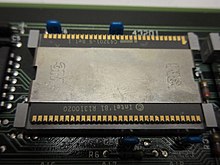Orphaned technology refers to computer technologies that have been abandoned by their original developers. As opposed to deprecation, which tends to be a gradual shift away from an older technology to newer technology, orphaned technology is usually abandoned immediately or with no direct replacement.[1] Unlike abandonware, orphaned technology refers to both software and hardware and the practices around them.

Users of orphaned technologies must often make a choice continuing to use the technology, which may become harder to maintain over time, or switch to other supported technologies, possibly losing capabilities unique to the orphaned technology.[citation needed]
Reasoning
editWhile technology can be abandoned due to an unfavourable design or poor implementation, abandoning a technology can happen for a variety of reasons.[1] There are instances where products are phased out the market because they are no longer viable as business ventures, such as certain medical technologies.[2]
Some orphaned technologies do not suffer complete abandonment or obsolescence.[citation needed] For instance, there is the case of IBM's Silicon Germanium (SiGe) technology, which is a program that produced an in situ doped alloy as a replacement for the conventional implantation step in silicon semiconductor bipolar process. The technology was previously orphaned but was continued again by a small team at IBM so that it emerged as a leading product in the high-volume communications marketplace.[3]
Technologies orphaned due to failure on the part of their startup developers can be picked up by another investor. One example is Wink, an IoT technology orphaned when its parent company Quirky filed for bankruptcy. The platform, however, continued after it was purchased by another company, Flex.[4]
Examples
editSome examples of orphaned technology include:
- Apple Lisa - 16/32-bit graphical computer
- Apple Newton PDA (Apple Newton) - tablet computer
- Apple Classic Mac OS - m68k and PowerPC operating system
- Coleco ADAM - 8-bit home computer
- DEC Alpha - 64-bit microprocessor
- Finale (scorewriter) music notation software developed by MakeMusic from 1988 until 2024[5]
- HyperCard - hypermedia
- ICAD (KBE) - knowledge-based engineering
- Javelin Software - modeling and data analysis
- LISP machines - LISP oriented computers
- Mattel Aquarius
- Microsoft Bob - graphical helper
- Mosaic notation program - music notation application by Mark of the Unicorn[6]
- Open Music System - Gibson[7]
- OpenDoc - compound documents (Mac OS, OS/2)
- Poly-1 - parallel networked computer designed in New Zealand for use in education and training
- Prograph - visual programming system
- TI 99/4A - 16-bit home computer
- Windows 9x - x86 operating system
Symbolics Inc's operating systems, Genera and OpenGenera, were twice orphaned, as they were ported from LISP machines to computers using the Alpha 64-bit CPU.[further explanation needed]
User groups
editUser groups often exist for specific orphaned technologies, such as The Hong Kong Newton User Group,[8] Symbolics Lisp [Machines] Users' Group (now known as the Association of Lisp Users),[9] and Newton Reference.[10] The Save Sibelius group sprang into existence because Sibelius (scorewriter) users feared the application would be orphaned after its owners Avid Tech fired most of the development team, who were thereafter hired by Steinberg to develop the competing product, Dorico.[11][12][13]
See also
editReferences
edit- ^ a b Leckie, Cameron (15 October 2010). "The abandonment of technology". resilience. Retrieved 2023-06-03.
- ^ Ritter, Arthur; Hazelwood, Vikki; Valdevit, Antonio; Ascione, Alfred (2011). Biomedical Engineering Principles, Second Edition. Boca Raton, FL: CRC Press. p. 457. ISBN 9781439812334.
- ^ Singh, Raminderpal; Oprysko, Modest; Harame, David (2004). Silicon Germanium: Technology, Modeling, and Design. Hoboken, NJ: John Wiley & Sons, Inc. pp. 40. ISBN 047144653X.
- ^ Staff, Connected World (October 2018). "October 2018: Abandoned Tech: When IoT Devices and Solutions Get Left Behind". Connected World. Retrieved 2019-07-16.
- ^ Dell'Era, Greg (2024-08-26). "The End of Finale". Finale. Archived from the original on August 26, 2024. Retrieved 2024-09-15.
- ^ (19 August 2008). Request by Sibelius users for a Mosaic to Sibelius conversion application. Sibelius (software)
- ^ (2 September 2009). Opcode Web site finally taken down. CNET
- ^ "Reliving Hong Kong Newton User Group". Archived from the original on 2007-03-11. Retrieved 2006-09-27.
- ^ "About Us". Association of Lisp Users. Archived from the original on 2013-01-21. Retrieved 2013-06-13.
- ^ "Newton Reference". Panix.com. 1998-02-27. Retrieved 2017-04-03.
- ^ Clark, Kevin. (15 November 2012). Keeping Score: Spreadbury Speaks on Sibelius Team Transition. Publisher: New Music USA (New York, USA)
- ^ (20 February 2013). Sibelius Core Team Now at Steinberg, Building New Notation Tool. Publisher: Create Digital Media (Berlin, Germany)
- ^ Spreadbury, Daniel. (20 February 2013). Welcome!. Publisher: Steinberg (Boston, USA)